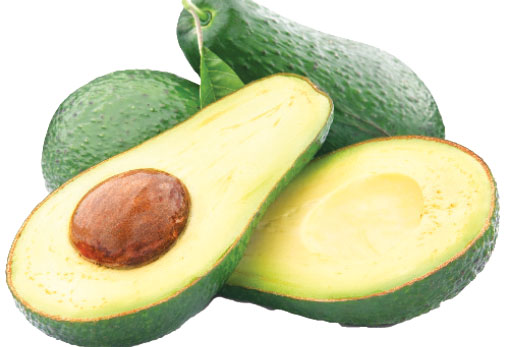the avocado (Persea americana) is a tree native to Mexico and Central America. But it is also planted, sold and consumed in Nigeria.
Classified in the flowering plant family of cinnamon, camphor and bay laurel, avocado or (alligator pear) also refers to the fruit, a large berry that contains a single seed.
Avocados are the fruit from the avocado tree, a tall evergreen tree that can grow up to 65 feet in height. They vary in weight from eight ounces to three pounds, depending upon the variety.
Commercially valuable and cultivated in tropical and Mediterranean climates throughout the world, the avocado has a green-skinned, fleshy body that may be pear-shaped, egg-shaped, or spherical. Commercially, it ripens after harvesting.
The avocado is a delicious and highly nutritious fruit, from which several recipes can be derived.
Consider adding avocado to salads, and not only on account of taste! Recent research has shown that absorption of two key carotenoid antioxidants – lycopene and beta-carotene –increases when fresh avocado (or avocado oil) is added to an avocado-free salad.
One cup of fresh avocado (150 grammes) added to a salad of lettuce, spinach, cabbage and carrots increases absorption of carotenoids from the salad between 200 to 400 per cent. Carotenoids are fat-soluble and would be provided with the fat they need for absorption from the addition of avocado. Interestingly, both avocado oil and fresh avocado added to meals increases carotenoid absorption.
Many avocado recipes that are in cookbooks and on the internet include avocado as an ingredient in its raw, unheated form. However, it is better, as it prevents any tampering of the unique and delicate fats in the avocado.
But if you require an avocado recipe that calls for heat, it is recommended that you use the lowest possible temperature and least amount of cooking time that will still work with your particular recipe. This is to help minimise damage to avocado fats. Approximately, 40 seconds of microwave on medium heat does not significantly change the fatty acid nutrients in avocado. Sometimes, it is better to add avocado to a dish that has been cooked.
If you are sincerely trying to eat healthier, you can swap equal amounts of avocado for butter in all your recipes for baked foods. Biscuits, cookies and banana bread taste more delicious when baked with avocado.
Not only is avocado delicious and a good substitute, it also has a lot of dietary and aestatic benefits too.
Health benefits
Lowers cholesterol levels: Avocado is rich in a compound called beta-sitosterol, which has been shown to be effective in lowering blood cholesterol levels.
Controls blood pressure: Also a great source of potassium, avocado helps in controlling blood pressure levels.
Promotes eye health: It is an excellent source of carotenoid lutein, which is known to help protect against age-related macular degeneration and cataracts – an eye defect.
Prevents birth defects and stroke: Rich in folate, a vitamin B commonly known as folic acid, one cup of avocado provides about 23 per cent of the recommended daily value of folate. The high amount of folate in avocado is essential in the prevention of birth defects.
The high levels of foliate in avocados may also protect against stroke.
Anti-ageing: Rich in antioxidants, avocado is beneficial in preventing ageing symptoms. The glutathione in avocado boosts the immune system, slows the ageing process, and encourages a healthy nervous system.
Skin care: The avocado oil is added in many cosmetics because of its ability to nourish the skin and make it glow. It also aids in treating psoriasis, a skin disease that causes skin redness and irritation.
Anti-inflammation: The term “anti-inflammation” can be used to describe avocado. The phytonutrient compound found in avocados, such as polyphenols and flavonoids, has been found to have anti-inflammatory properties, thereby reducing the risk of inflammatory and degenerative disorders.
Getting the best of avocado
The method used in peeling the avocado can make a difference. Research has shown that the greatest concentration of carotenoids in avocado occurs in the dark green flesh that lies just beneath the skin; so you do not want to slice away that dark green portion of the flesh any more. Therefore, it is better to peel the avocado with the fingers.


